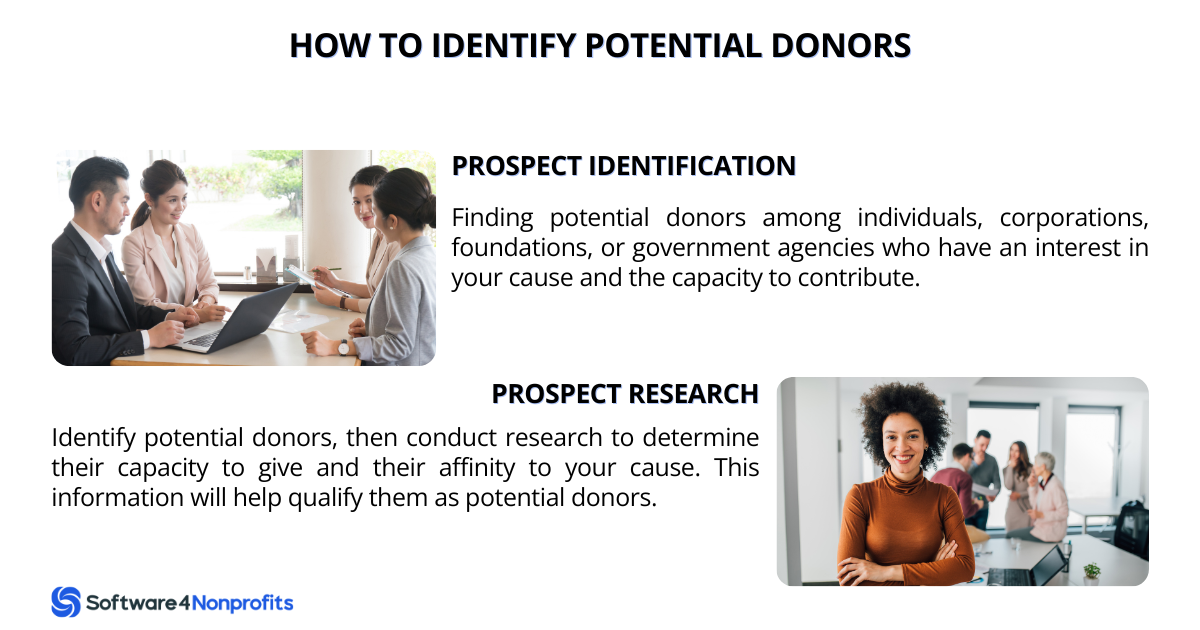In the ever-evolving landscape of nonprofit fundraising, the Donor Cultivation Cycle remains a constant compass. It guides organizations through the key stages of building and nurturing donor relationships. The cycle comprises several stages that help organizations engage with donors and encourage them to give more consistently and generously over time.
We will explore each stage of the donor cultivation cycle, best practices for each stage, and tips for success.
Stage 1: Prospect Identification and Research
The first step of the donor cultivation cycle is prospect identification and research. This stage involves identifying potential donors who have an interest in your organization’s mission and the capacity to make a significant contribution. Once identified, research can be conducted to learn more about each prospect, including their philanthropic history, interests, and giving patterns. The goal of this stage is to create a list of prospects who are most likely to become engaged with your organization and make a significant contribution.

Prospect Identification
Prospect Identification is about discovering individuals or entities that might be inclined to support your organization. These prospects could be individuals, corporations, foundations, or government agencies. The goal is to find those who are not only able to give but are also likely to be interested in your cause.
Prospects can be identified through various sources:
- Internal Database: Organizations often start with their internal contact lists, which might include past donors, volunteers, event attendees, and newsletter subscribers. This pool can be a goldmine as these individuals already have some level of engagement with your organization.
- Referrals: Personal and professional networks can also be a rich source of potential donors. Board members, volunteers, existing donors, and staff may have connections to individuals or entities that might be interested in supporting your organization.
- Wealth Screening Services: Wealth screening is a process that helps nonprofits identify potential donors based on their financial capacity. This service is often provided by specialized third-party companies that use advanced algorithms and comprehensive databases to analyze a person’s wealth.
- Public and Online Sources: Public and online sources offer insights into potential donors’ interests, affiliations, and financial capacity. These sources include public records (property, business, court), social media platforms, philanthropy-related databases, and news articles. They help organizations better understand prospects and tailor their fundraising approaches.
Prospect Research
Once potential donors have been identified, the next step is to conduct in-depth research to qualify these prospects. This research should aim to uncover two key pieces of information: the prospect’s capacity to give and their affinity to your cause.
- Capacity: This refers to the prospect’s financial ability to make a donation. It can be assessed through publicly available information such as property ownership, stock holdings, business affiliations, and philanthropic history.
- Affinity or Linkage: This is about the prospect’s connection to, or interest in, your organization or cause. It can be determined through their past giving (both to your organization and to others with a similar mission), volunteer work, personal experiences, public statements, and social media activity.
Prospect research can be time-consuming, but there are various tools and resources to assist in this process, ranging from specialized prospect research databases to social media platforms and search engines.
Conducting thorough prospect identification and research is crucial to the success of the Donor Cultivation Cycle. It allows organizations to focus their efforts on the most promising prospects, thereby maximizing their fundraising efficiency and effectiveness. Moreover, the insights gained during this stage can inform subsequent cultivation strategies, making them more personalized and thus more likely to resonate with the prospects.
Stage 2: Cultivation and Engagement
The second stage of the donor cultivation process is cultivation and engagement. This stage involves building relationships with prospective donors by educating them about your organization’s mission and impact and getting them involved in your activities.
The goal of this stage is to build trust and rapport with prospective donors so they feel connected to your organization and motivated to support your cause through major gifts or monetary donations.

Make a Donor Cultivation Plan
Create a major donor cultivation plan for each prospect, including personalized communication and engagement opportunities. Your cultivation plans should outline the steps you will take to build a relationship with each prospect. It should include personalized communication, such as phone calls, emails, or handwritten notes, as well as engagement opportunities such as tours, events, or volunteer opportunities.
Messaging Framework
Develop a messaging framework that articulates your organization’s mission and impact. Your messaging framework should be a consistent and compelling narrative that communicates the impact of your organization’s work. It should resonate with your target audience and inspire them to get involved.
Opportunities for Potential Donors
Provide opportunities for potential donors to get involved in your organization, such as volunteering or attending events. Providing engaging opportunities for existing and new donors can help them understand the impact of your organization’s work and build a sense of connection.
Donor Recognition Program
Create a donor recognition program to acknowledge and thank donors for their support. A donor recognition program should be designed to show appreciation and gratitude for a donor’s contribution. It can include public recognition, such as creating a donor base on your website, or in your annual report, or more personalized recognition, such as handwritten notes or phone calls.
Regular Communication
Regularly communicate with potential donors to keep them informed about your organization’s activities and impact. Consistent communication especially an in-person meeting helps to maintain the relationship with potential donors and keeps them engaged with your organization. Use a variety of communication channels, such as email, social media accounts, and newsletters, to share updates and impact stories.
Stage 3: Solicitation and Ask
The third stage of the donor cultivation cycle is solicitation and ask. This stage involves making a request for a donation and asking for support. The goal of this stage is to secure a commitment from potential donors and turn them into active supporters of your organization.
Personalized Ask Strategy
Develop a personalized ask strategy for each prospect that takes into account their interests and capacity to give. Your ask strategy should be tailored to each prospect and should be informed by your research and cultivation efforts. Consider the prospect’s giving history, philanthropic interests, and financial capacity when developing your strategy.
Personal Meetings
Make the ask in person whenever possible, as it can help build trust and rapport. A personal ask can be more effective than an email or letter. It provides an opportunity to have a conversation and build a deeper relationship with the donor.
Storytelling and Impact Stories
Use storytelling and impact stories to illustrate the difference a donation can make. Donors want to know how their contribution will make a difference. Use stories and data to illustrate the impact of your organization’s work and how their donation will be used.
Variety in Giving Options
Provide different giving options, such as recurring donations or planned giving. Offering a variety of giving options can make it easier for donors to support your organization in a way that works best for them.
Following Up with Donors
Follow up with donors after the ask, regardless of the outcome, to continue the relationship and show appreciation. Following up after an ask is an opportunity to show appreciation and gratitude for the donor’s consideration. Even if the donor decides not to give, it’s important to continue to cultivate the relationship for future opportunities.
Stage 4: Stewardship and Acknowledgement
The fourth and final stage of the donor cultivation cycle is the donor stewardship plan and acknowledgement. This stage involves recognizing and thanking donors for their contributions and demonstrating the impact of their support. The goal of this stage is to strengthen the relationship between your organization and donors and inspire ongoing support.
Personalized Acknowledgement Strategy
Create a personalized acknowledgement strategy for each donor that includes a thank you note, phone call, direct mail, or recognition in your annual report. Acknowledging a donor’s contribution is an important step in building a lasting relationship. Personalize your acknowledgement strategy to reflect the donor’s interests and preferences.
Share Impact and Success Stories
Share the impact of the donor’s contribution, such as the number of people served or the program’s success. Donors want to know that their contribution is making a difference. Use data and impact stories in different ways to demonstrate the impact of their support.
Provide Engagement Opportunities
Provide opportunities for donors to get involved in your organization’s activities, such as volunteering or attending events. Donors who are more engaged with your organization’s fundraising cycle are more likely to give again in the future. Provide opportunities for donors to get involved and experience the impact of your organization’s work firsthand.
Regular Updates to Donors
Keep major and even one-time donors informed about your organization’s activities and impact through regular communication. As stated earlier, one-on-one meetings could be the best way to maintain the relationship with donors and it keeps them engaged with your organization. Share updates, impact stories, and upcoming events on a regular basis.
Encourage Feedback
Solicit feedback from donors especially first-time donors to learn more about their interests and preferences and improve your donor cultivation cycle. Asking for feedback from donors is a valuable way to understand their interests and preferences and improve your cultivation efforts. Use surveys or one-on-one conversations to gather feedback and make improvements.
Conclusion
The donor cultivation cycle is a critical process for building and strengthening relationships with donors to inspire ongoing support. By following the best donor cultivation strategies for each stage of the cycle, nonprofits can create a sustainable and effective fundraising process that engages donors and inspires continued support. While each stage of the cycle is important, it’s important to remember that donor cultivation is an ongoing process that requires consistent effort and attention.
Finally, it’s important to track and measure the effectiveness of your donor cultivation efforts. By tracking metrics such as donor retention rate, average gift size, and donor engagement level, nonprofits can identify areas for improvement and adjust their strategy accordingly.



